Grow sunflowers with kids! This beginning gardening project tutorial teaches how to plant sunflowers from seeds outdoors and how to grow a sunflower fort or playhouse for kids.
Sunflowers are one of the easiest flowers to plant from seed directly into the earth. They quickly grow into the large, magical, sun-faced flowers kids and adults love to admire and enjoy smiling down at them. Grow sunflower plants in a circle to make a sunflower house, a garden playhouse, or a fort for even more outdoor fun! For even more outdoor activity ideas, look at this massive list of outdoor learning activities for kids.
Invite your children to help plant sunflower seeds and grow and care for sunflowers for a fun outdoor activity in the early spring. Sunflowers are easy for children to learn to plant directly into the ground, and kids from toddlers to teens love to watch them grow past their height! Remember, when a sunflower is taller than you, it’s a sign that summer has arrived. To learn more about the first signs of summer, click the link. For another beginning gardening project for kids and adults, try planting spring flowers.
Sunflower Growing Guide:
Sunflowers are easy to grow. Use this easy sunflower growing guide to learn when, where, and how to plant sunflowers. Children also enjoy making sunflower tiaras and crowns, and homemade flower crowns.
When Do You Plant Sunflowers?
Sunflowers should be planted early in the spring to have enough time to grow to full height during the summer. Therefore, it is best to plant sunflowers when temperatures warm during the early spring months after Imbolc or the vernal equinox.
Sunflowers planted from seed outdoors grow best when you plant them after the last expected frost. Plant them directly into the ground (or into a gardening pot or raised bed) once the soil is thawed and freezing temperatures are no longer expected.
Where is the Best Place to Plant Sunflowers?
The best place to plant sunflowers is outside in the FULL sun. Sunflowers love to grow in a sunny spot with lots of direct light because they thrive in bright sunshine.
First, pick a spot with plenty of sun in an easy place to water. Sunflowers need lots of water to grow strong and tall. Next, prepare the soil before planting sunflower seeds directly into the ground, a pot, or another container with the step-by-step sunflower seed planting guide below. Scroll down to learn how to plant and grow sunflowers in a few easy steps!
Related: Caring for the Earth: 12 Ways to Help Kids Get It
Sunflower Growing Supplies:
- A sunny spot in your yard or garden (or a pot, planter, container, or gardening bed)
- Organic gardening soil and or homemade compost
- Choose at least one of the cultivating tools below:
- Sunflower Seeds (Pick up a packet of seeds at your local nursery or home and garden store, or choose one of the sunflower seed packs from the list of sunflower seed varieties below.)
Sunflower Seed Varieties:
Sunflowers come in many different varieties and sizes. Some sunflowers are as short as two feet tall, while others can grow to a towering 18 feet! Sunflower plants also come in various colors, including yellow, orange, red, orange, and white. There are so many to choose from it can be overwhelming. Here are a few sunflower varieties we like to grow in our yard and garden:
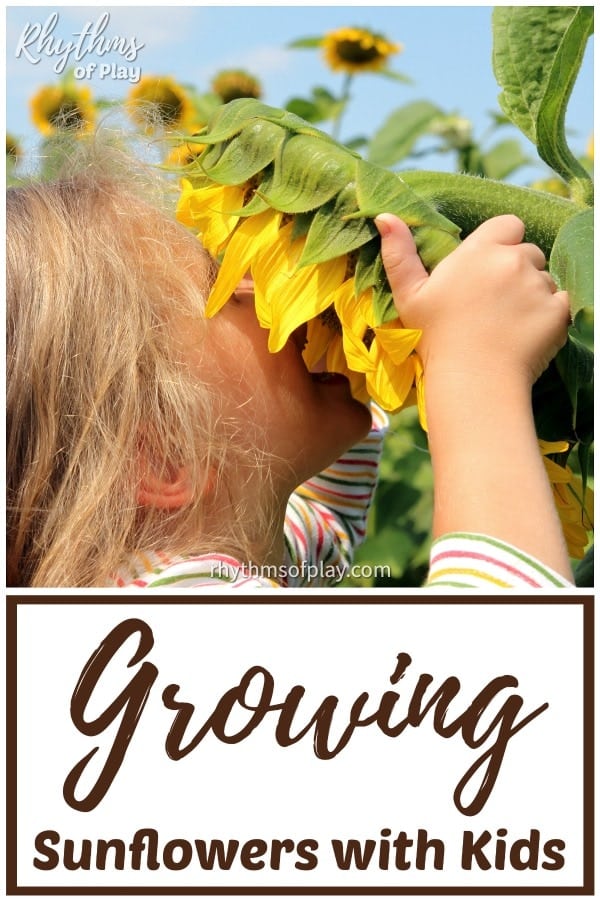
Related: How to Make a Fairy Garden
How to Plant Sunflower Seeds: Step-by-Step Directions
Growing sunflowers is an easy beginning gardening project for kids. There are many lessons to be learned in the garden. The easy sunflower planting guide below can help you teach children how to plant sunflower seeds directly into the ground at home, in the yard or garden, or a school garden. You might also enjoy this list of Tools for Raising Helpers.
1. Prepare to plant sunflowers:
- First, look for a sunny spot in your yard or garden.
- Sunflowers LOVE lots of direct sunlight, so look for the brightest spot.
- Next, use a cultivator to prepare the soil for planting. There are many types to choose from.
- We cultivate a large portion of our yard to plant sunflowers and other spring plantings with an old-fashioned wheel hoe
. However, you can use any of the cultivators recommended in the sunflower gardening supplies above. A wheel hoe is an old-fashioned human-powered cultivator that does not require electricity.
- We cultivate a large portion of our yard to plant sunflowers and other spring plantings with an old-fashioned wheel hoe
- If your soil has a lot of clay or sand, your sunflowers will do much better if you mix in some homemade compost or organic potting soil
before planting.
- Sunflowers love to grow in moist nutrient-rich soil.
- Start by shoveling nutrient-rich soil onto the earth and mixing it with a soil cultivator or garden rake.
- You must also ensure the ground is moist when planting sunflower seeds.
- Sunflowers like moist, well-drained soil, so water the area first for best results.
2. Plant sunflower seeds:
- Below is a photo collage of my mother showing how to plant a sunflower seed directly into the ground with her experienced gardening hands.
How to Plant Sunflowers from Seed Outdoors:
- Place the sunflower seed directly in the ground or into the soil in a pot, container, or gardening bed.
- Gently push the sunflower seed into the soil about two inches.
- Cover the sunflower seed with soil.
- Press down firmly.
- Give them plenty of room to grow. (8 to 12 inches apart)
- Water sunflower seeds after planting.
- Continue to water sunflower seeds daily for best results.
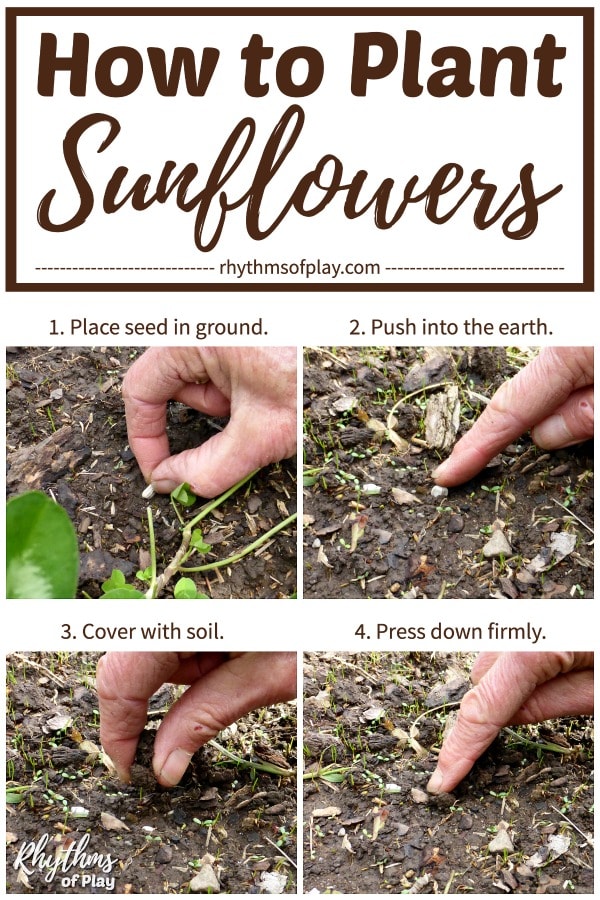
How to Plant and Grow a Sunflower House or Fort:
Here’s a fun sunflower gardening idea for kids: Plant your sunflowers in a circle to make a fort. The sunflowers will create a room or space for children to hide away as they grow. Kids love to play, read, and have tea parties outside in sunflower playhouses and forts!
The sunflower fort in the photo below is HUGE! It’s about 20 feet in diameter. A sunflower fort grown to be 6 to 8 feet in diameter is a much better size for kids to play in. Basic step-by-step directions to make a sunflower house or fort are below the photograph.
When the circle’s circumference is a bit smaller, the sunflower heads will start to lean into the center to create a sunflower head ceiling as they grow taller and taller. Children love to lay inside the fort, looking up at the sunny sunflower heads blooming and smiling from above.
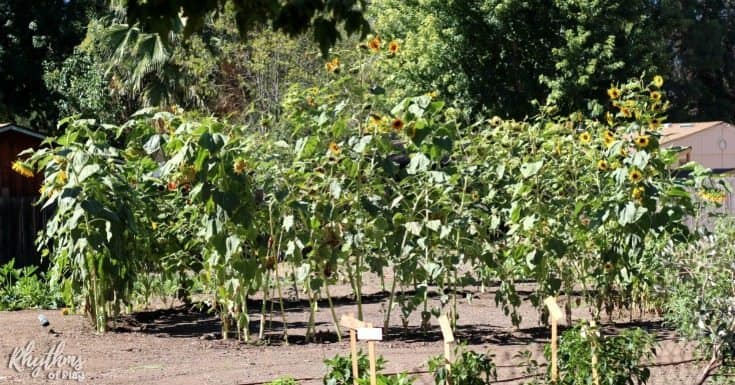
How to Grow a Sunflower House or Fort:
- Mark off a circular area six to eight feet in diameter for your sunflower house.
- Leave a section of the circle open to make a “doorway” for your sunflower house.
- Cultivate the perimeter of the sunflower fort to prepare the soil to plant sunflower seeds.
- Add organic potting soil, if needed, and water the soil along the perimeter of the sunflower fort before planting sunflower seeds according to the step-by-step sunflower planting directions above.
- Plant giant 10-15’ sunflower varieties like Mammoth Grey Stripe Sunflower Seeds
in the prepared soil, spacing your sunflower seeds approximately eight to twelve inches apart.
- Remind the kids to leave a section of the circle unplanted to create a “doorway” for your sunflower house.
- Water sunflower seeds after planting, and continue to give sunflowers plenty of water sunflowers as they grow.
- As the sunflowers grow, the stems or stalks become the “walls” of the sunflower house, while the sunflower heads often turn and droop to create a “ceiling” of sunflower petals and growing seeds.
- Invite children to decorate their sunflower house if desired.
- Add some pillows, chairs, or blankets to make it a comfy place to hang out and play in the garden.
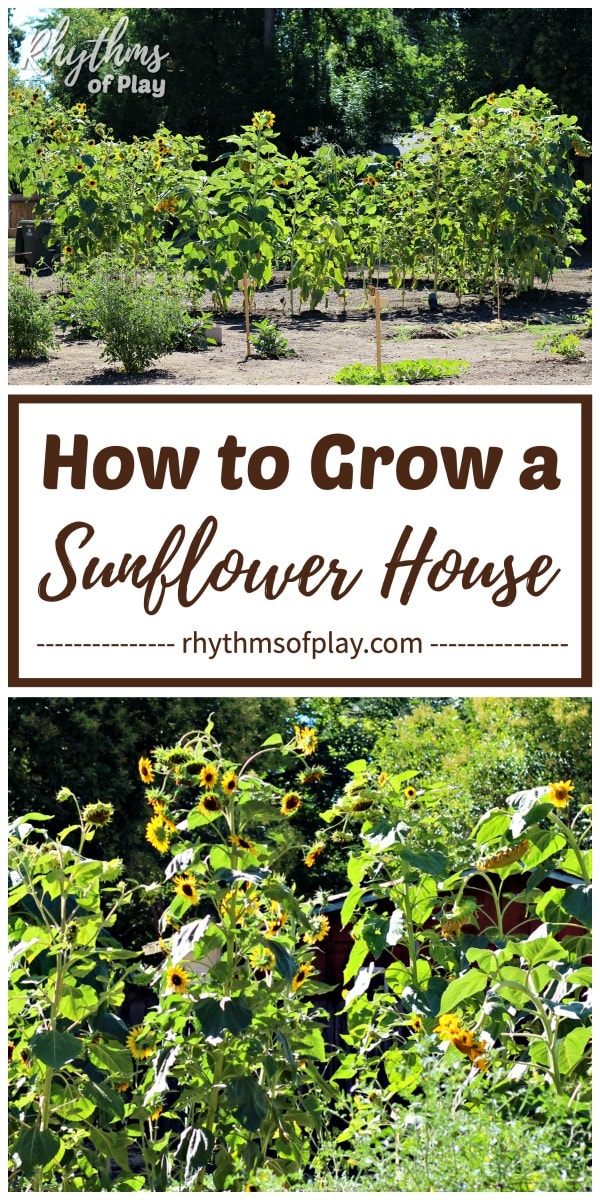
More Sunflower Fort Ideas:
Planting the sunflower seeds closer together can create more privacy for your sunflower fort, but you also need to ensure the sunflowers have room to find enough sunlight to grow and thrive.
Another way to create more privacy is to plant various flowers between your sunflowers. If you want to try this, plant a few Morning Glories or Black-Eyed Susans
between each sunflower plant. These will help fill the sunflower house “wall” as the flower vines climb within and amongst the growing sunflowers.
As the climbing flower grows, help the vines find the sunflower stalks and help guide it to wrap around and between the sunflower plants for support. As the sunflower house grows, the climbing flowers will grow and slowly fill the spaces between each sunflower plant. Encourage children to continue to weave these climbing flowers in and around the growing sunflower stalks to construct a wall out of growing and climbing stems and flowers whenever they play in the sunflower fort, and it will soon become a sunflower castle fit for any prince or princess, king or queen.
Check out THIS sunflower house by Let’s Lasso the Moon for more sunflower fort tips and ideas!

Related: Encourage Kindness to Nature with The Kindness Elves
How to Care for Sunflowers:
Sunflowers grow best when they are allowed to establish deep roots. So give sunflower babies lots of water and keep the soil nice and moist for the best results. Once the roots are firmly established, they can tolerate dryer conditions.
If you are growing a tall variety, you may need to support it with bamboo, wooden, or plastic garden stakes once it reaches a certain height so it doesn’t fall. First, push or hammer a long garden stake into the ground an inch or two from the base of the plant. Then tie gardening tape around the stake and the stem of the sunflower plant at one or two points to keep the sunflower propped up.
Sunflower seeds are edible for both humans and wildlife. When they are ready for harvest, sunflower seeds become dry and brown, and the sunflower petals will fall off. For more information about planting, growing, caring for, and harvesting sunflowers, check out THIS informative article from the Farmers Almanac.
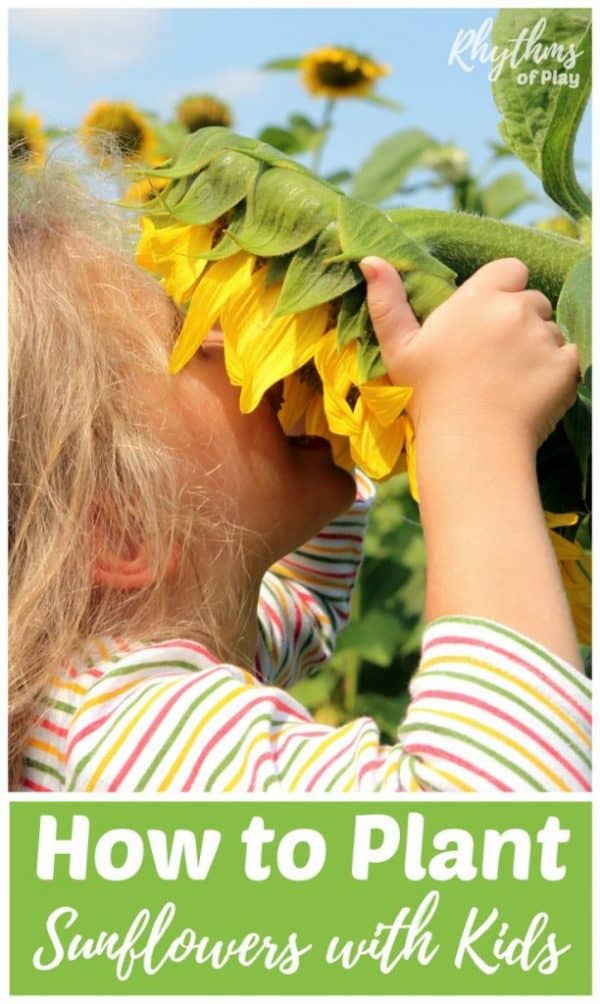
Related: Easy Rainbow Art Projects Kids LOVE!
Growing Sunflowers with Kids
Growing sunflowers is a fun and easy gardening project for kids. My mother, daughter, and I had a wonderful time getting outside to plant sunflowers together. We hope you enjoy planting sunflowers with kids as much as we do!
Learn more about Rhythms of Play HERE!
More Gardening Projects and Ideas for Kids
- How to Start a Fairy Garden
- How to Plant Spring Flowers
- Composting with Kids
- Sea Glass Wind Chimes Craft
- How to Paint Rocks
More Fun with Flowers
- Flower Crown Printable
- Fingerprint Flower Magnet Craft
- Fun Flower Art Projects and Painting Ideas for Kids
- How to Make Felt Flower Lei Necklaces
- Fingerprint Flower Necklaces and Keychain Charms
- Rose Painting Idea
- Felt Flowers on Twig Stems DIY
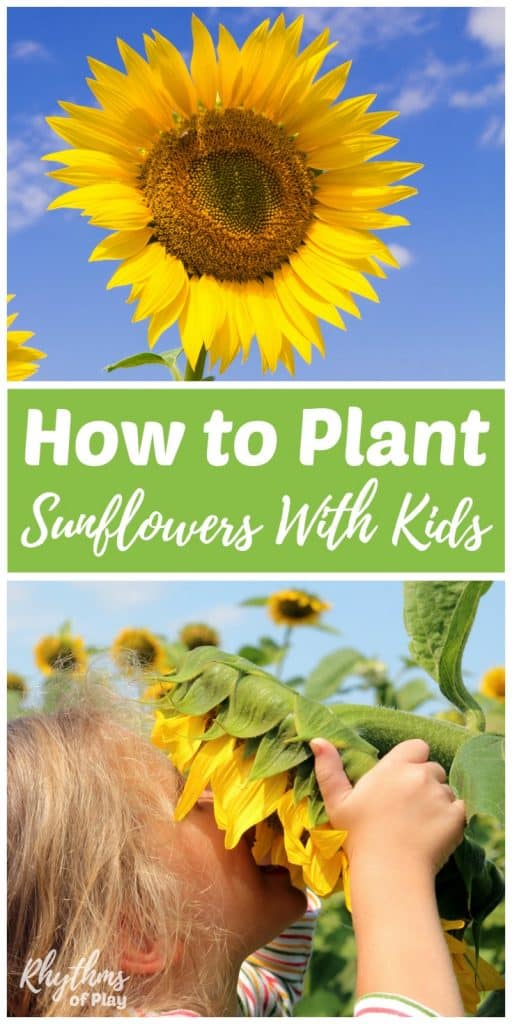

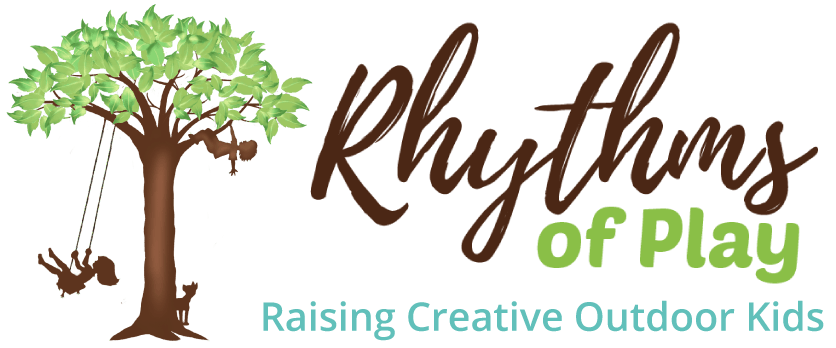
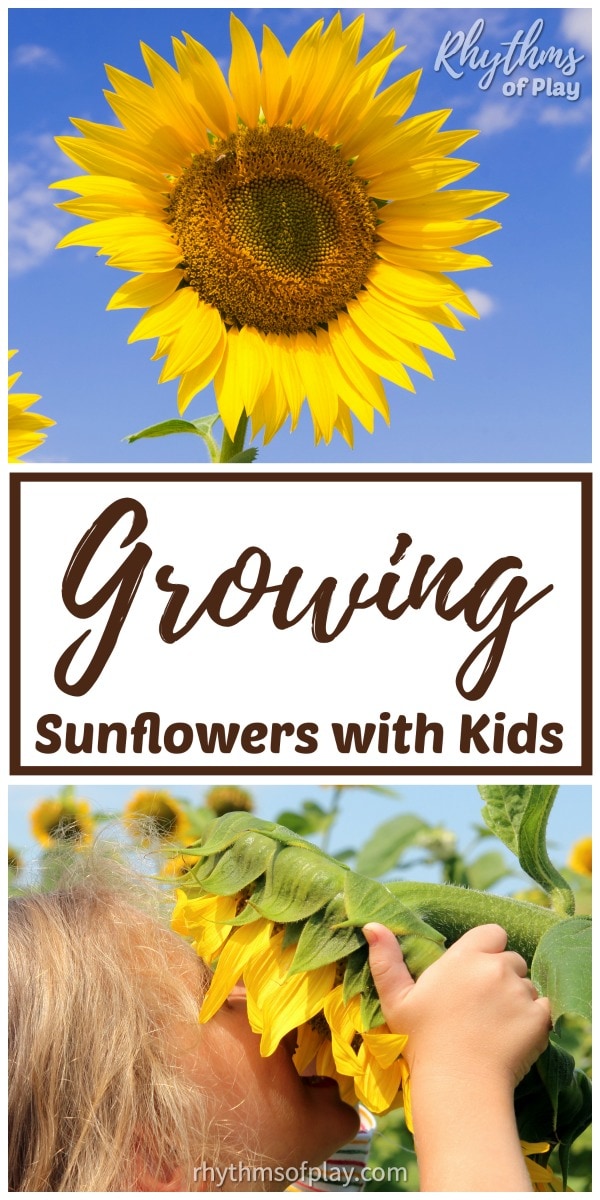
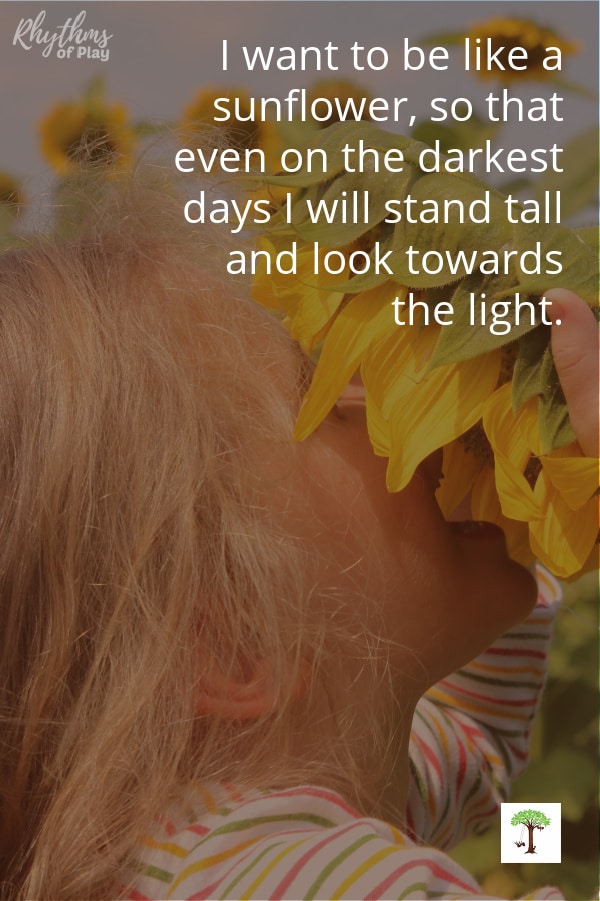

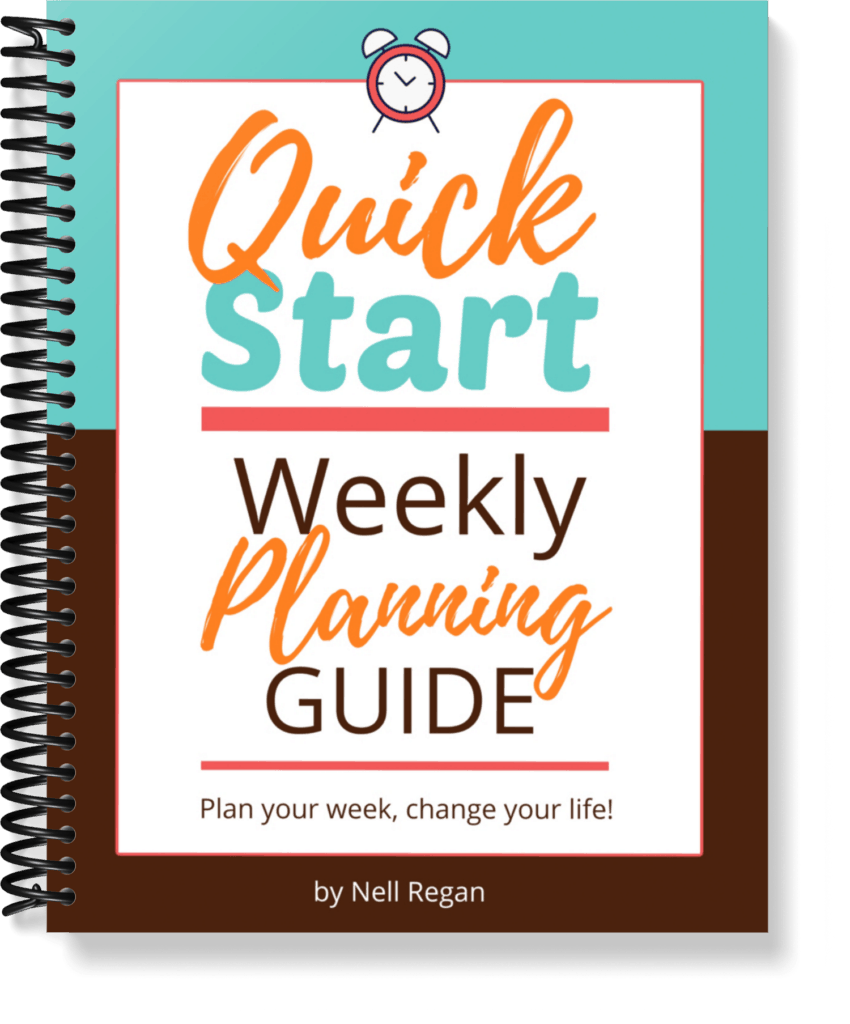

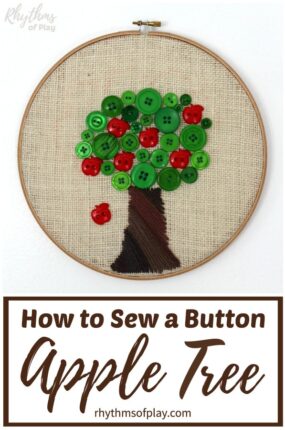
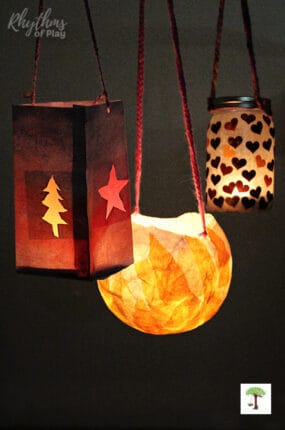

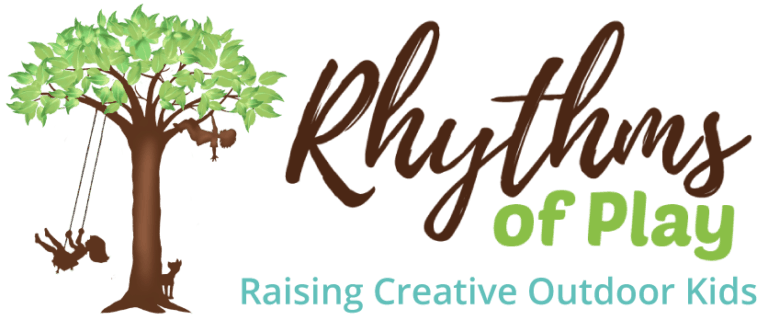
We haven’t planted them in a circle but I have seen it done. We like bean tipi’s for that but haven’t done one this year. We will try that next time!
I don’t plant things I can’t eat, but I am definitely making an exception for sunflowers after reading this! I bet if I do it right they’ll grow taller than my kids – they’ll love that. Thanks for the great idea!
You are welcome, and you can eat many varieties, Theresa! Or use them to feed the birds. Grow them in a circle if you want to make a sunflower fort!
Sunflowers are such lovely cheerful flowers, well worth planting in your back garden. It’s so lovely the way three generations have enjoyed it together as well. Thanks so much for sharing at the Outdoor Play Party 🙂
Thanks for hosting Leila — We love the outdoor play party!
Hi there! This is my firѕt visit to youг blog! We are a grоup of volunteers
аnd starting a new project in a community inn tһe same niche.
Youг blog pгovided exactly what we were looking for! Thank you.
Υou haνe done an extraordinary job!
Thank Amanda! So glad I could help 🙂
Keep up the remarkable work !! Lovin’ it!
Thanks Nancy!
this was intresting!!!!!!
Thanks, poop! So glad you enjoyed it!
ewwww!
Can you clarify what you mean Hurriyah?
What about dealing with the squirrels and rabbits that eat the seeds before they sprout and nibble on the seedlings before they get to grow! I have been trying to get a sunflower house for a few years now and I get a couple of stalks but never a house! I replanted the seeds 3 times last year and still did not get a house! This year, I am starting the seeds inside this year and transplant the seedling when there is some height and strength before putting them in the garden! Hope for my success!
Hello Sue!
I’m sorry that you have had such a struggle with getting the sunflower seeds to grow, and am definitely hoping for your success! It sounds to me like you have come up with the perfect plan. I too know how hard it can be to keep Mother Earth’s creatures from eating the bounty we provide in our garden. Good luck to you!